The Ultimate Hunting Caliber Chart: Quickly Pick the Best Cartridge for Each Species
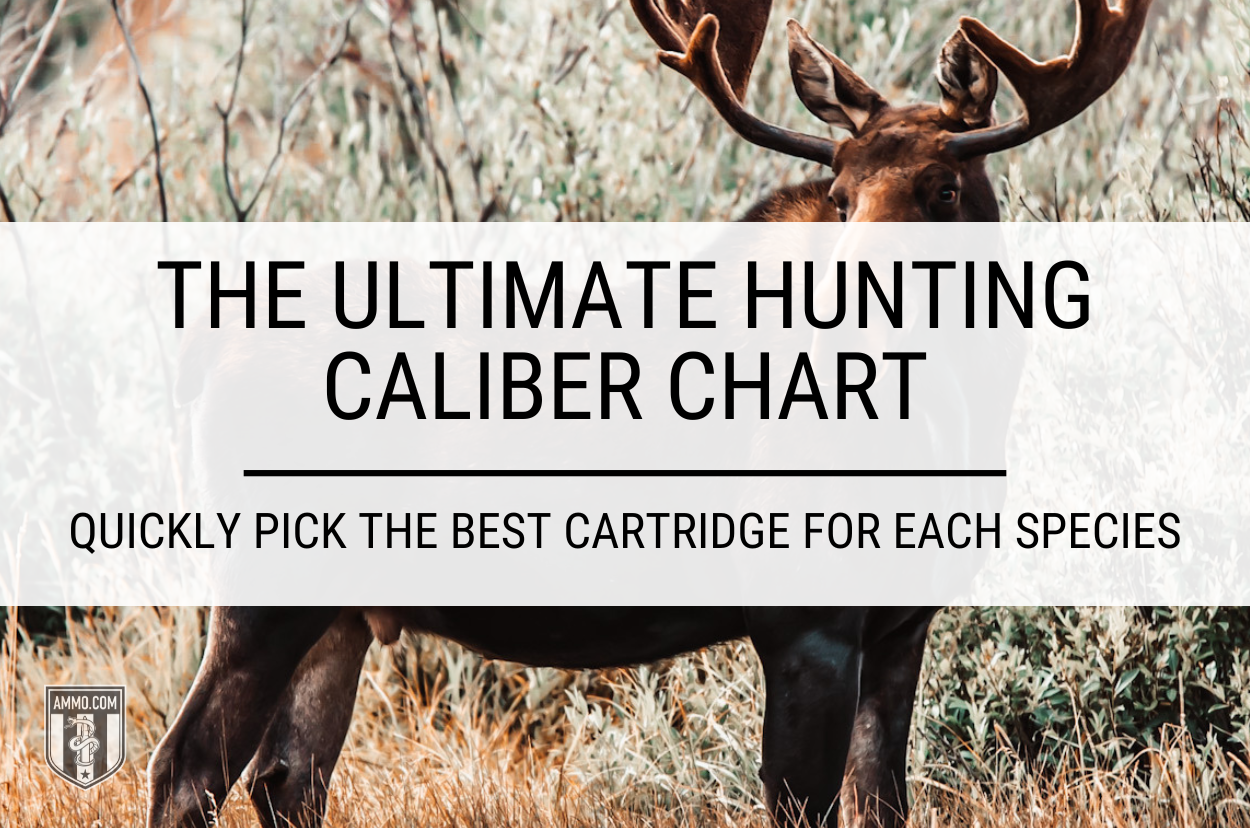
Choosing the correct hunting caliber and cartridge will keep you legal and make you more successful during your hunts.
Read on to discover which cartridges are the most popular for hunting each species. Note that you should always check your local and state hunting regulations, as some states only allow specific cartridges for hunting certain game animals.
Best Small Game Hunting Calibers

Squirrel Hunting Calibers
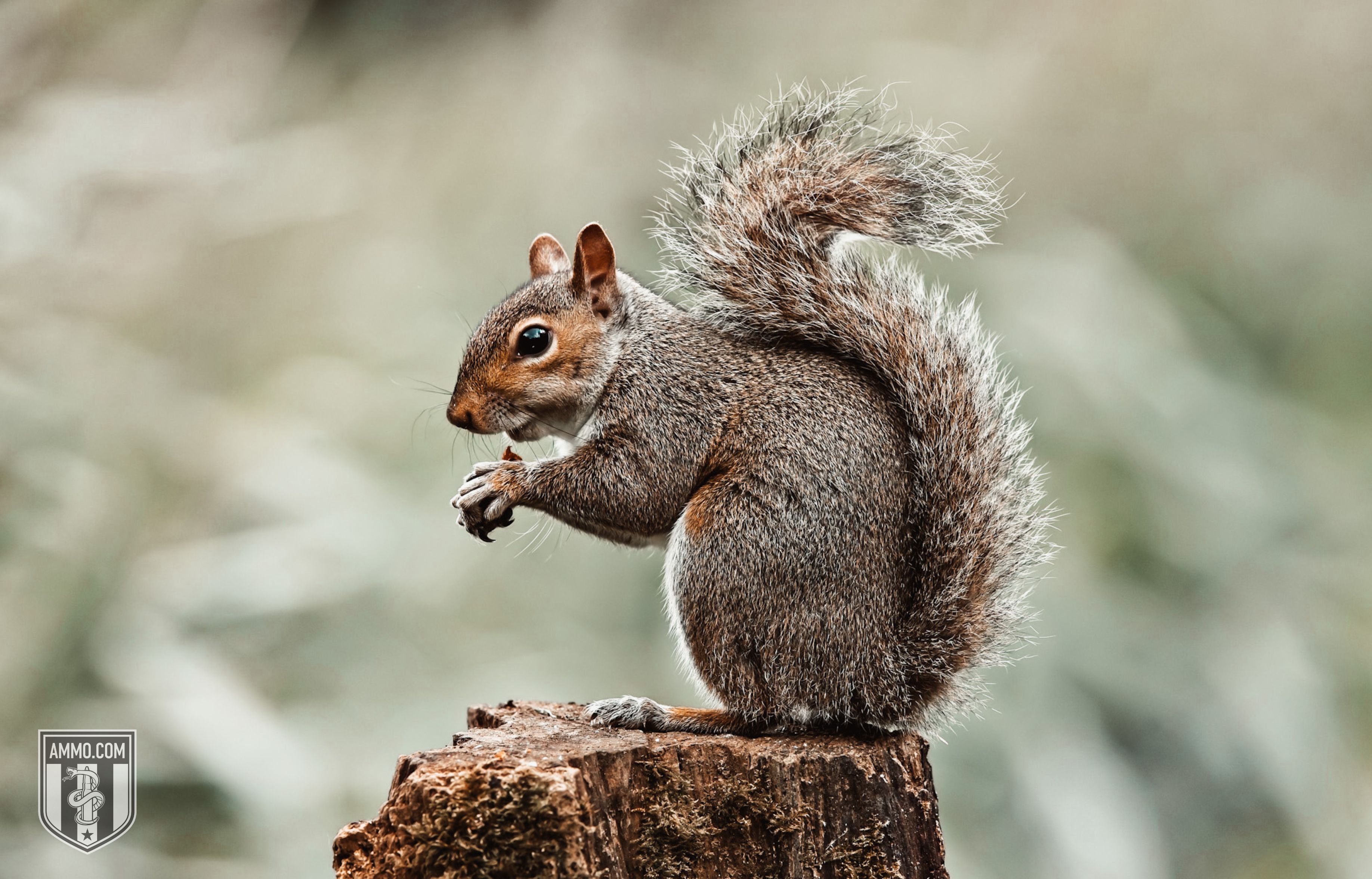
It’s always best to match the size of the game to the size of the cartridge. Doing so allows you to destroy less meat and have a better hunting experience.
The most popular handgun and rifle calibers for squirrels are:
- .177 Pellet
- .17 HM2
- .17 Hornady Magnum Rimfire (HMR)
- .22 Long Rifle (LR)
- .22 Winchester Magnum Rimfire (WMR)
| Caliber | Description |
|---|---|
| .177 Pellet | As a kid, I ran around with a BB gun until upgrading to a .177 air rifle. Air pellets are great because they destroy less meat and are nearly silent. Take care that they are more affected by wind, and have a shorter effective range compared to other rifle cartridges. |
| .17 HM2 | Designed for varmint hunting, the .17 Hornady Mach 2 is accurate and flat-shooting, with virtually no recoil. It ballistically outperforms the .22 LR and is often better for hunting small game in populated areas. |
| .17 HMR | My introduction to the .17 HMR was squirrel and rabbit hunting. I was shocked at the tiny projectile's effectiveness (up to 200 yards), but it also ruined more meat than the .22LR we used. |
| .22 LR | The .22 LR has caused more nightmares for squirrels than any other cartridge. It’s my top choice for squirrel hunting because it’s cheap, accurate, and effective out to about 75 yards. (.22 LR aficionados can stretch it to 100 yards.) |
| .22 WMR | The .22 WMR has a flatter trajectory and more range than the .22 LR. It can be used on some medium-sized game, but it will damage more meat and is more expensive to fire. |
Shotguns are another fine choice for squirrel hunting. Common squirrel hunting shotgun gauges are:
While the gauge is important, the shot size is the most critical consideration when hunting with shotguns. #6 shot is my go-to shot size for squirrel hunting, but #5, #7, #8, and #9 are also effective. Lead is commonly used, but many public lands require you to use non-toxic (e.g. steel, tungsten or bismuth) loads while hunting. Always check the local regulations before heading out.
Common squirrel hunting shot sizes:
- #9 Shot
- #8 Shot
- #7 Shot
- #6 Shot
- #5 Shot
Rabbit Hunting Calibers
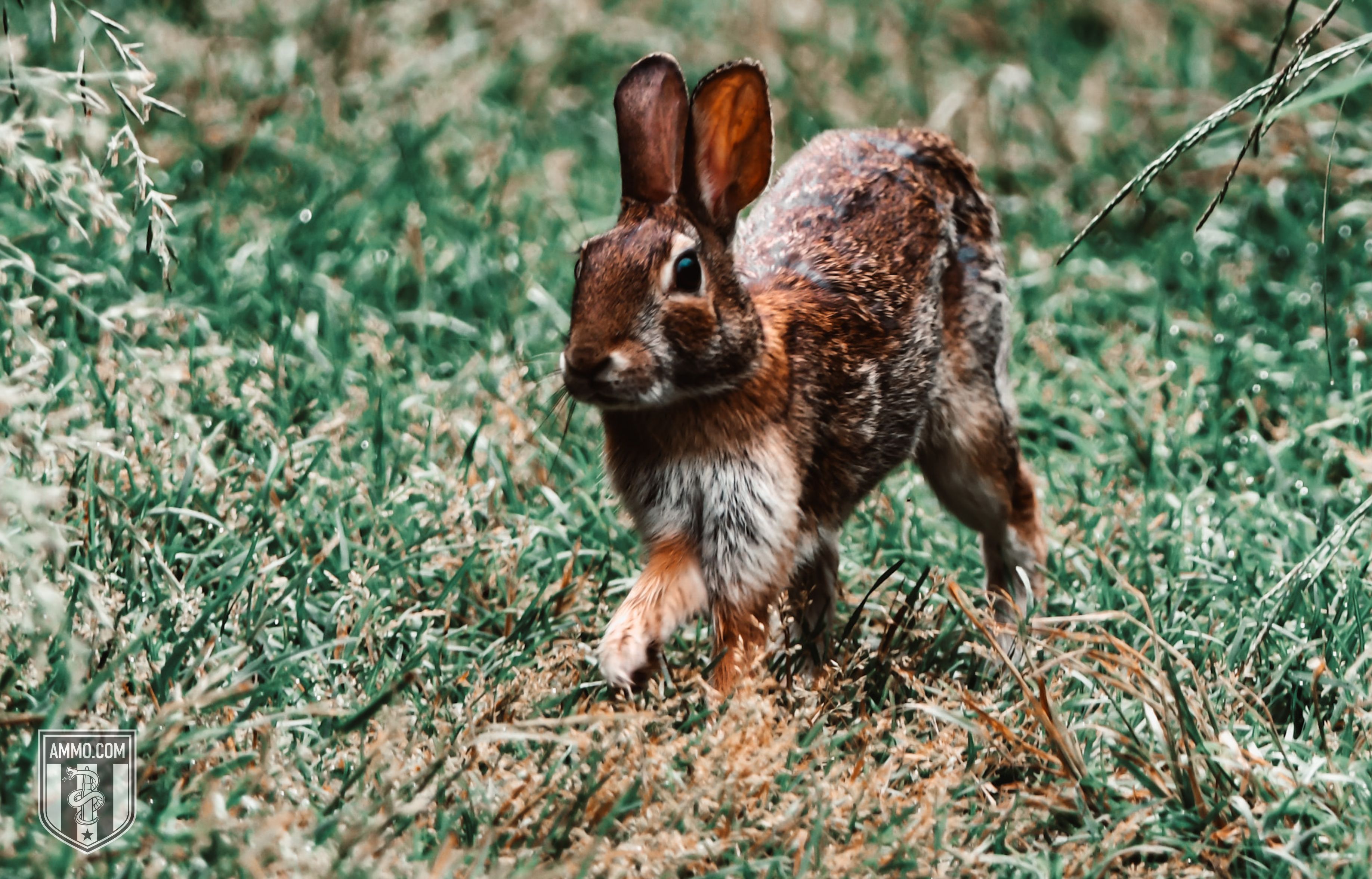
Since rabbits are still relatively small, you can often use the same calibers and cartridges for both. You can also use some slightly larger cartridges. Common rabbit hunting cartridges are:
| Caliber | Description |
|---|---|
| .17 HMR | The .17 HMR is effective out to 200 yards on rabbits and is very accurate. However, it can damage the meat of cottontail rabbits because they’re smaller. |
| .22 LR | The .22 LR has likely harvested more rabbits than all other cartridges combined in the last 100 years. However, because of the trajectory, accuracy tends to decline at 75 yards. |
| .22 WMR | The .22 WMR is more powerful than the .22 LR, so it has a flatter trajectory (out to 100 yards). It has the same caliber bullet, but it’s also more expensive. |
| .22 Hornet | The .22 Hornet fires a high-velocity 35 to 45 grain bullet. It has largely fallen out of favor during recent decades, and will be very difficult to find for sale. |
| .204 Ruger | The .204 Ruger is an incredibly high-velocity, flat-shooting round. It is best for long-range shots (150-400 yards). It’s also much more expensive than .22 LR, so if you plan to shoot a lot, this probably isn’t the cartridge for you. |
| .222 Remington | The .222 Rem is another flat-shooting, high-velocity cartridge – perfect for long-distance shots, but certain to damage more meat and cost more than .22 LR. |
| .223 Remington | The .223 Rem offers lightweight bullets at high velocities, but it’s sure to damage lots of meat on cottontail rabbits. It’s best reserved for jackrabbits and long shots. |
When hunting rabbits within 50 yards, I often opt for a shotgun. The gauge will affect your range, recoil, and pattern density, but I grew up using a .410 Bore and 20 gauge and currently use a 12 gauge. Shot size that should be your primary concern. The best shot sizes for rabbit hunting are:
- #9 Shot
- #8 Shot
- #7 Shot
- #6 Shot
- #5 Shot
- #4 Shot
Dove, Quail and Upland Hunting Loads
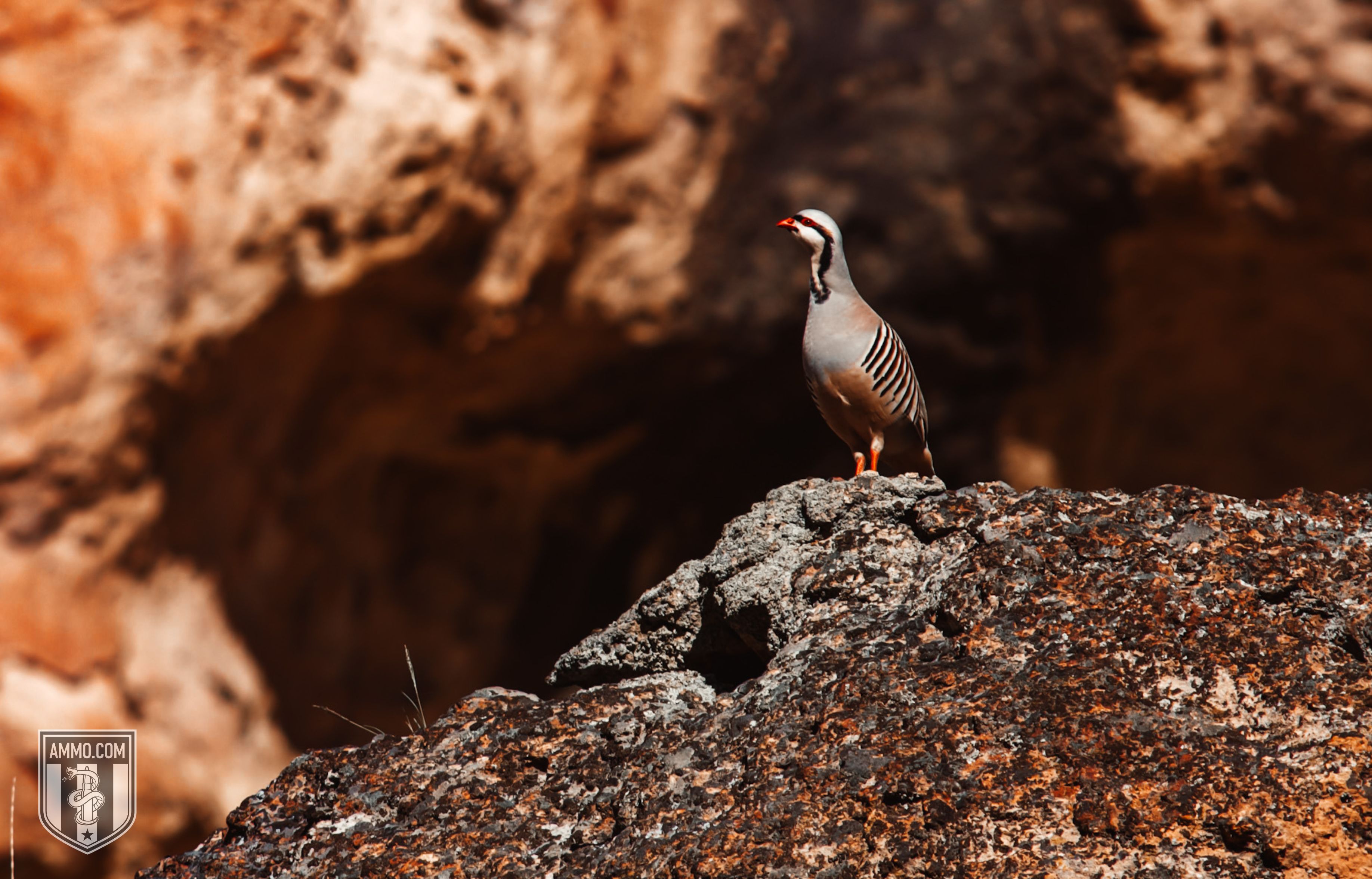
In most cases, you must use a shotgun when wingshooting (turkey is the lone exception). Small game birds like dove and quail require smaller shot sizes to avoid damaging too much delicate meat. I typically use the following shot sizes when dove, quail, and upland bird hunting:
- #9 Shot
- #8 Shot
- #7.5 Shot
- #6 Shot
- #5 Shot
- #4 Shot
| #6 Shot | #6 shot is often the largest shot size I use for dove hunting (unless I’m desperately low on shotgun shells). |
| #7 Shot | #7 shot is an excellent choice. It’s not so large that it will destroy the meat, but it is large enough to drop a hard-to-hit bird. |
| #8 Shot | I also like the #8 shot. If you find yourself struggling to hit birds with a shotshell loaded with #7 shot, try switching to a #8 or #9 shot (or changing your shotgun choke). |
| #9 Shot | I don’t use much #9 shot, as the tiny pellets don’t retain as much energy downrange as the larger pellets do. If you plan on close shots, then #9 is a suitable option. |
The Smaller shot size has more pellets in the shotshell than a larger shot size. A #9 shot pellet is smaller than a #6 shot pellet. The same can be said for increasing the gauge: a 12 gauge shotshell will have more pellets per shotshell than a 20 gauge shotshell of the same shot size and length.
Pheasant Hunting Loads
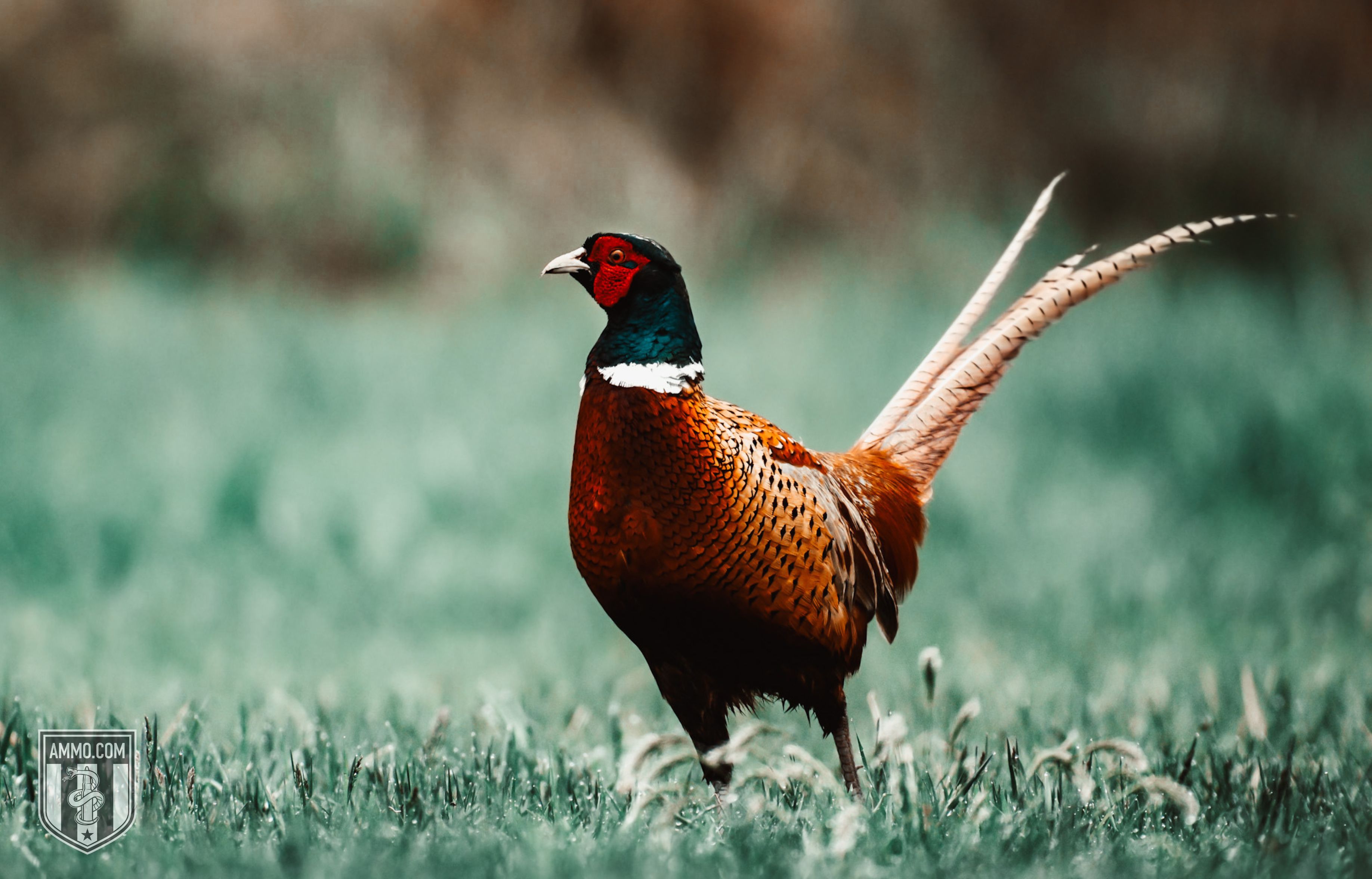
When hunting pheasants and other large upland game birds, you might need to step up to #4 shot – but other sizes will work. The most common shot sizes used for pheasant hunting are:
- #5 Shot
- #4 Shot
- #3 Shot
| #3 Shot | If you know the area you’re hunting tends to have skittish birds, you might want to step up to #3 shot. The larger pellets will carry more energy downrange. |
| #4 Shot | #4 is the go-to shot size for many pheasant hunters and should be one of your top choices for these birds. |
| #5 Shot | While you could use a smaller shot than #5 to hunt pheasants successfully, I don’t recommend it unless you’re struggling to hit a bird and need a few extra pellets from downsizing. |
Duck Hunting Loads
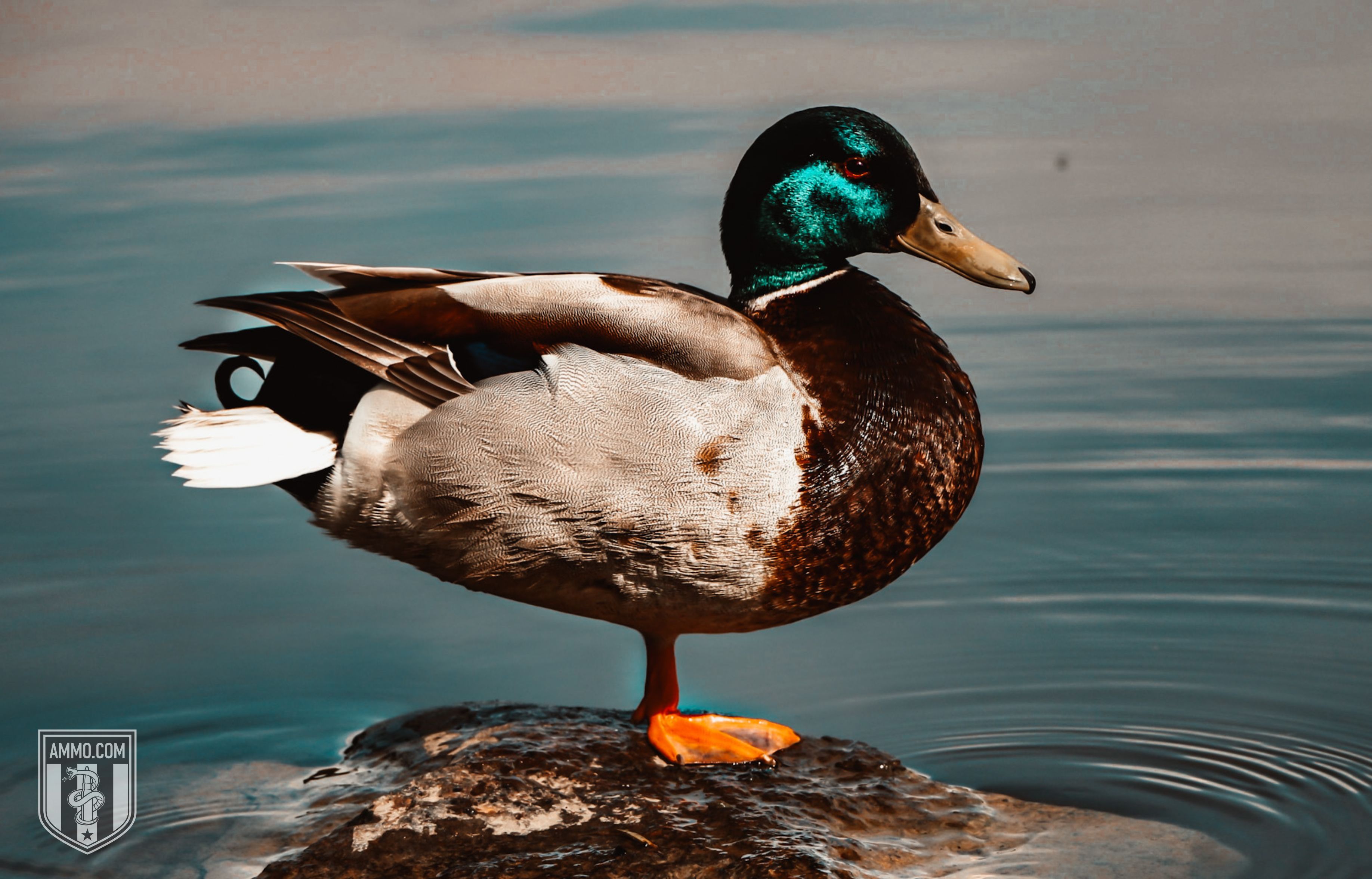
Waterfowl are a little tougher than upland birds due to their increased size and down feathers, so using a 20 gauge or 12 gauge is often best. However, a .410 will get the job done if you're up for a challenge. You’ll also have to use nontoxic loads like steel, bismuth, or tungsten.
For smaller ducks, such as teal, #4 shot will be plenty. For larger ducks, like mallards, I like to use #2. Those aren’t the only options you have for ducks either. Here are several more:
- #5 Shot
- #4 Shot
- #3 Shot
- #2 Shot
- #1 Shot
- BB Shot
| #5 Shot | When hunting small divers and teal, #5 shot will keep you from destroying meat – but it will mean you’ll need follow-up shots on larger ducks. |
| #4 Shot | #4 shot is an excellent all-around size for waterfowl. It's my go-to as it has plenty of stopping power but doesn’t destroy smaller ducks. |
| #3 Shot | I have never hunted duck with #3 shot, as I primarily use #4 or #2, but I don’t see any reason why it wouldn’t work if you can find it. |
| #2 Shot | #2 shot is my other favorite for duck hunting, but it can be a bit much for smaller ducks (especially at close range). |
| #1 Shot | #1 is another shot size that I haven’t hunted with because it’s an in-between size, but I see no reason why it wouldn’t work. I’ll use #2 or BB when hunting big ducks and small geese. |
| BB Shot | BB is generally considered a goose shot size, but I’ve also found it beneficial for large ducks (especially in late winter when their down is thickest). |
Goose Hunting Loads

Your shot size for goose hunting will be determined by the size of the geese you’re hunting. Local Canada geese in my neck of the woods require at least #2, but I prefer BB and larger because they’re giant. Migraters like snow geese are smaller, so they are easier to take using smaller pellets like #4 because they’re about the size of big mallards.
Here are the best goose hunting shot sizes for 20 gauge and 12 gauge:
- #4 Shot
- #2 Shot
- BB Shot
- BBB Shot
- T Shot
| #4 | The smallest pellet size I use for geese is #4, and that’s often a last resort for smaller geese. |
| #2 | #2 is a solid all-around choice as it has plenty of stopping power for bigger geese, but it is not overpowering for smaller geese. |
| BB | BB is my go-to for goose hunting because I hunt a lot of massive local geese and I need that extra knockdown power. |
| BBB | BBB is a shot size I use sparingly. It’s overkill for smaller geese, but sometimes necessary for the large locals. |
| T | T shot should be saved for Sandhill crane and swan hunting, but I had a buddy who used them for the giant local geese. I'm not sure he hit anything, despite his shoulder being sore after the hunt from shooting a lot. |
Turkey Hunting Cartridges & Loads
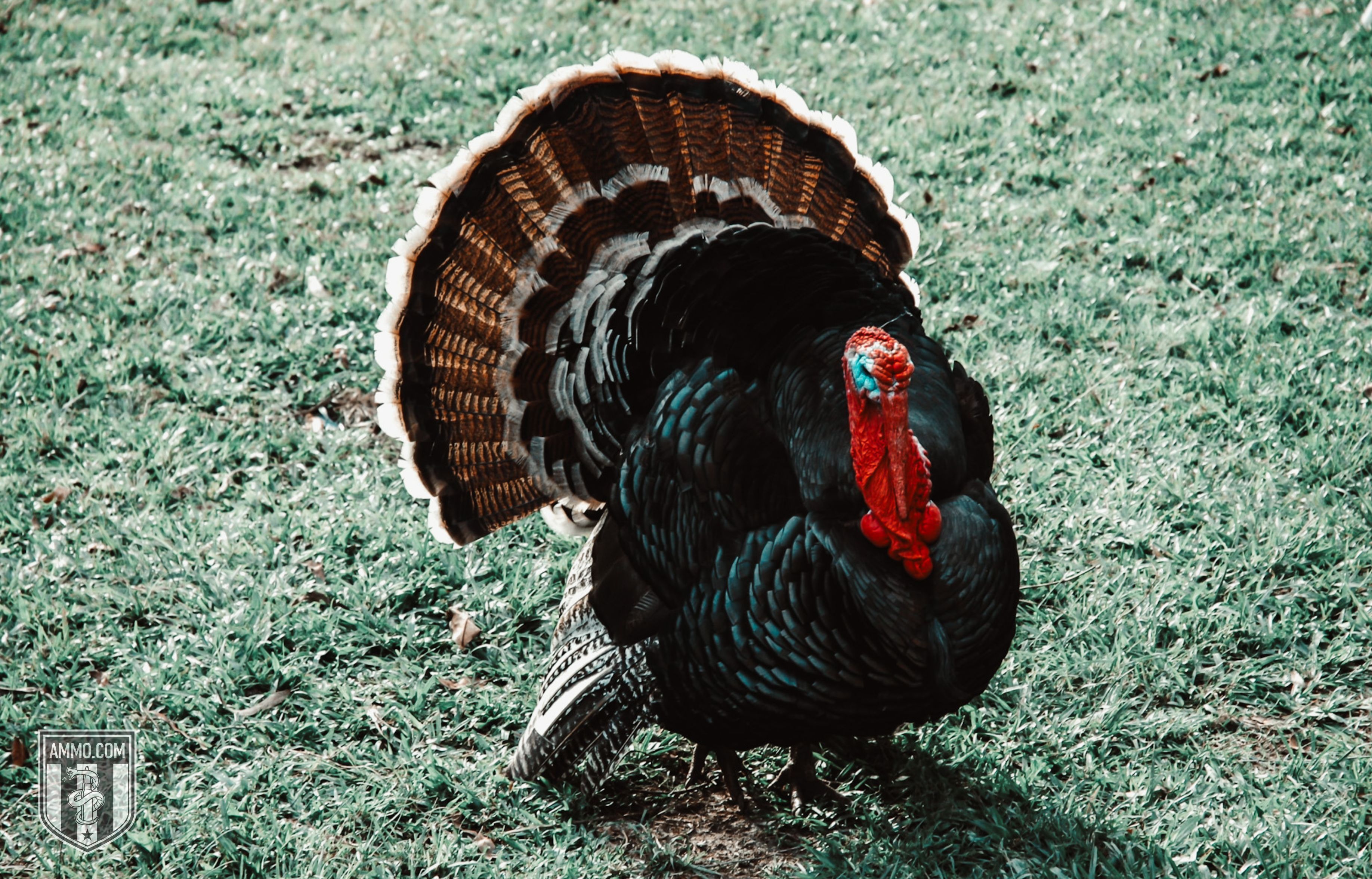
Some states allow turkey hunters to use rifles, but most folks still prefer shotguns. .410 bore shotguns have exploded in popularity among turkey hunters, but the trusty 12 and 20 gauge shotguns are still a primary choice for many.
Most turkey loads are #4 and #5 shot, but #6 shot also works. You might also stumble across turkey loads that combine multiple shot sizes.
| #4 | #4 is often the largest shot size you’ll see in turkey loads, as larger pellets will damage too much meat. |
| #5 | #5 shot is always a safe bet because it’s a happy medium. You still get lots of pellets with plenty of knockdown power. |
| #6 | When hunting at closer ranges or smaller turkeys, #6 shot is plenty capable of harvesting a turkey. |
Some rifle cartridges can also be used for turkey hunting, such as:
| .22 WMR | The .22 WMR is the ideal rifle cartridge for turkey hunting within 75 yards, as it won’t damage too much meat but still has plenty of knockdown power. |
| .22 Hornet | The .22 Hornet is the best option for longer ranges (up to 200 yards), but it can be too powerful and damage too much meat at close ranges. |
| .223 Rem | Some recommend the .223 Rem with a 35 grain bullet, but even that can be too overpowering for a turkey. I only recommend using the .223 for long shots. Definitely don’t use a larger caliber. |
Best Medium Game Hunting Calibers

Fox & Coyote Hunting Calibers

Varmints like foxes and coyotes tend to have thin skin compared to game animals like deer. They’re also prized for their furs, which means using large-caliber bullets is less than ideal. While most medium-sized game can be taken with buckshot at close range, a rifle is often preferred.
| .17 Hornet | The .17 Hornet is an excellent cartridge for shots within 200 yards that causes minimum damage to the pelt. |
| .17 HMR | The .17 HMR is less than ideal for anything over 50 yards. If you enjoy calling predators in close, this is the cartridge for you. |
| .22 WMR | Another close-range option. The .22 WMR is most suitable for taking game within 100 yards. |
| .204 Ruger | The .204 Ruger is a high-velocity round that can ethically kill a coyote or fox at 400 yards. If you enjoy long-range hunting, this is the cartridge for you. |
| .223 Rem | If you’re less worried about damaging the pelt and want to increase your range, you can always step up to a .223 Rem or larger caliber. You can ethically harvest coyotes and foxes out to 500 yards with a .223 Rem. |
| .22-250 Rem | Another long-range option is the .22-250 Rem. This cartridge is a coyote's nightmare, flat shooting out to 200 yards and typically dropping about 4 inches by 300 yards. |
| .220 Swift | The aptly named .220 Swift is a high-velocity flat-shooting round. It’s very accurate to well over 500 yards and still carries plenty of energy downrange. |
| .243 Win | The .243 is most often thought of as a big game cartridge, and rightfully so: It will damage a pelt, even at a long distance. Don’t use it if you care about the condition of your trophy. |
| 6mm Creedmoor | The 6mm Creedmoor is another predator management cartridge that should not be used for fur harvesting. It carries plenty of energy to take coyotes and foxes beyond a quarter of a mile. |
Coyotes and foxes can also be taken with a .410 bore, 20 gauge, or 12 gauge shotgun at close range. The best shot sizes for this are:
- #4 buckshot
- #1-4 buckshot mix
- #3
- #2
- #1 buckshot
- 0 Buckshot
- 00 buckshot
Antelope Hunting Calibers
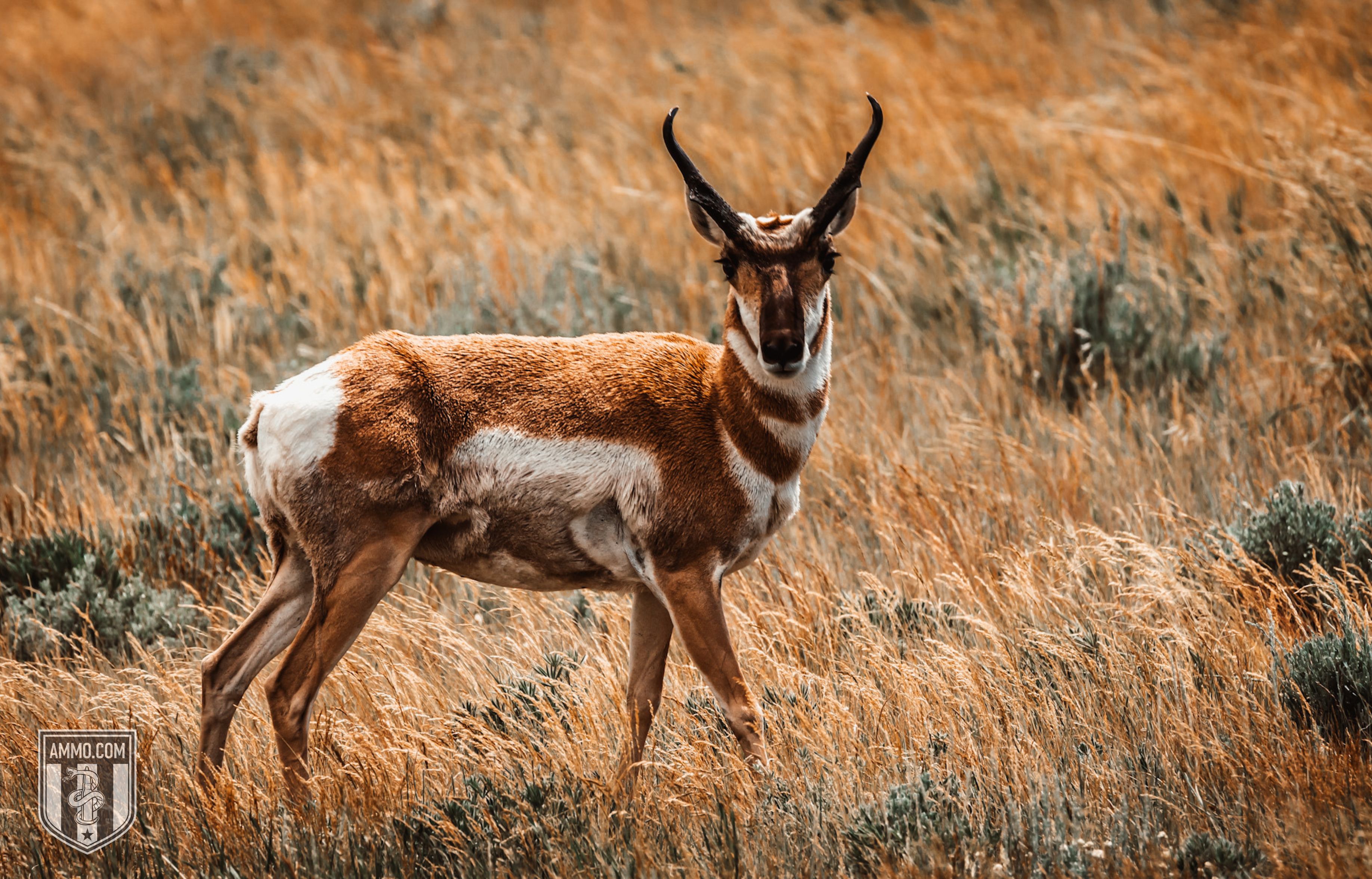
Antelope and pronghorn are fast and wary animals. While you might get a close shot because of their environment, you will likely have to cover a distance of 300+ yards. These distances call for a flat-shooting, high-velocity cartridge. The calibers most often used for Pronghorn hunting are:
- .22-250 Rem
- .243 Win
- 6.5mm Creedmoor
- .257 Weatherby (WBY)
- .270 Win
| .22-250 Rem | As we learned in the coyote section, the .22-250 Rem is a flat-shooting, high-velocity cartridge, which makes it perfect for antelope standing up to 350 yards away. |
| .243 Win | To increase your range a little more, step up to the .243 Win. Maxing out around 400 yards for pronghorn, the .243 Win is flat, accurate, and has minimal recoil while also maintaining the energy needed to harvest an antelope ethically. |
| 6.5 Creedmoor | The 6.5 Creedmoor is a proven long-range target round that offers hunters an accurate, flat-shooting, low wind-drift bullet that can extend range to over 500 yards. |
| .257 WBY | The .257 WBY fires a lightweight bullet. Its high velocity enables it to carry enough energy to be effective on pronghorn out to 400 yards. |
| .270 Win | I love my .270 Win and see no reason it wouldn’t make a solid antelope hunting cartridge – except for the trajectory. The .270 fires a larger bullet at lower velocities, which hurts its trajectory. However, it’s still capable of taking pronghorn out to 400 yards. Larger calibers can take pronghorn, but they are often overkill, damaging too much meat. |
Mountain Goat Hunting Calibers

Mountain goats live in a challenging terrain, making them difficult to reach, so a flat-shooting cartridge is often used to hunt these animals. It doesn’t have to be a magnum or giant caliber because mountain goats aren’t big animals, and you’ll need a lightweight rifle while hiking up the mountains. Some of the most popular calibers are:
| .270 WSM | The .270 WSM is a magnum cartridge designed for a lightweight rifle. It has a solid trajectory and is capable of taking goats out to 400 yards. |
| .22-250 Rem | If you know you’ll be able to get a little closer, the .22-250 Rem can take goats out to 200 yards while maintaining a flat trajectory. |
| 6.5 Creedmoor | The 6.5 Creedmoor is a flat-shooting round that is more than capable of ethically harvesting mountain goats out to 500 yards. |
| .260 Rem | Though the .260 Rem doesn’t have the range of the 6.5 Creedmoor, it’s still an excellent option for shots out to 400 yards. |
| .308 Win | There’s a reason hunters have loved the .308 Win for nearly 75 years: It’s a capable, flat-shooting cartridge, and .308 hunting ammo is readily available. |
Hog Hunting Calibers
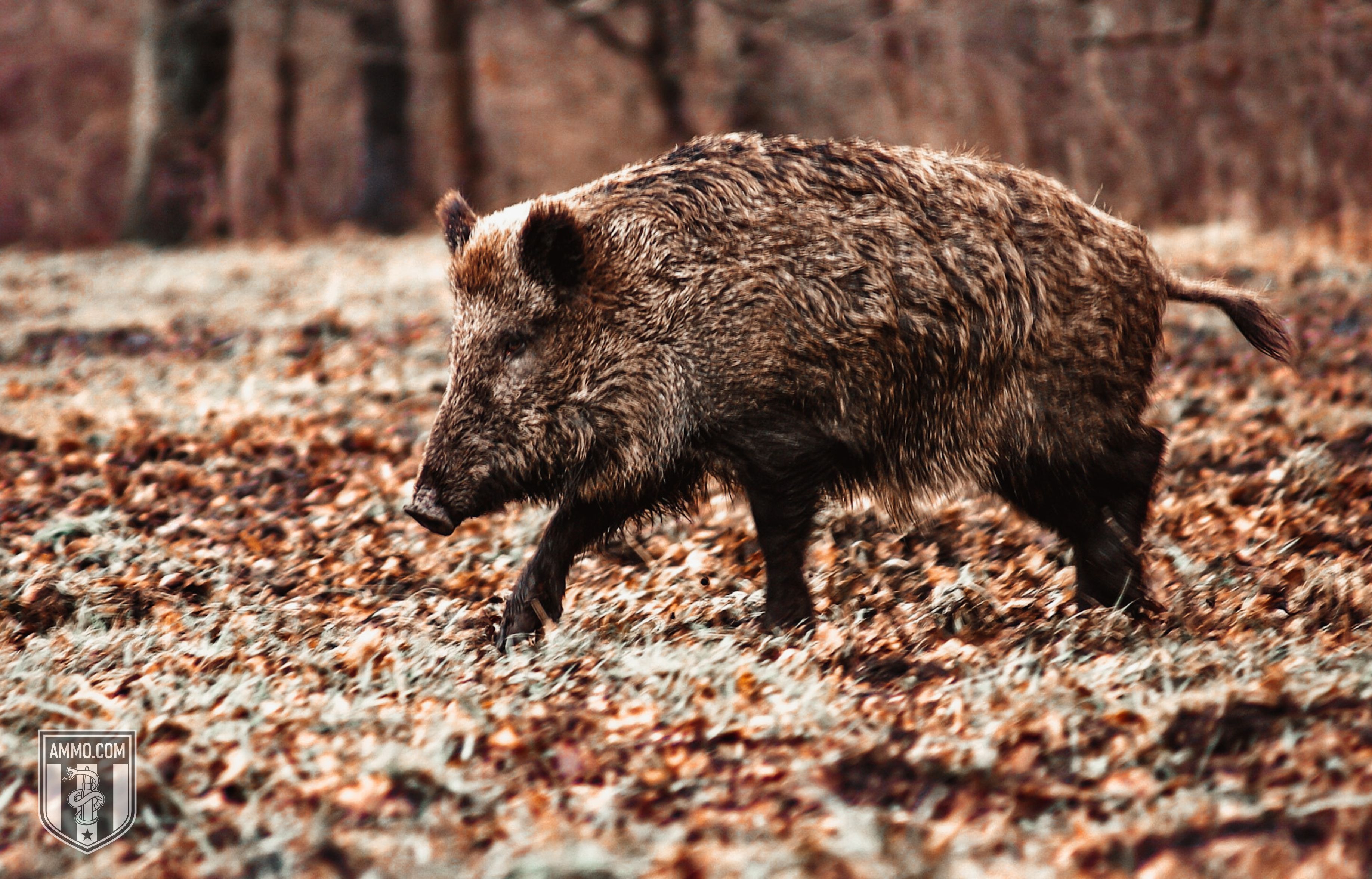
Wild hogs are tough animals and often live in rough environments. I’ve taken wild pigs with a .30-30 Winchester at close range, but other calibers are often more effective. Several of the standard hog hunting cartridges are:
- .357 Mag
- .45 ACP
- .44 Mag
- 12 Gauge
- .243 Win
- 6.5 Creedmoor
- .270 Win
- .30-30 Win
- 7mm-08 Rem
- .30-06 Springfield
- .308 Win
- 7mm Rem Mag
- .300 Win Mag
| .357 Mag | Whether you have it chambered in a handgun or lever-action carbine, the .357 Magnum is great for defense against an angry boar at close range. |
| .45 ACP | The .45 ACP is another round commonly carried by pig hunters as a last resort or defense. It’s not their primary, but it gets the job done at close range. |
| .44 Mag | If you want a bullet that’ll stop a hog dead in its tracks at close range, the .44 Magnum is the one you want. |
| 12 Gauge | Although uncommon, a 12 gauge with 000 buckshot can effectively drop a hog (or two) at close ranges (within 75 yards). |
| .243 Win | I prefer something a little more substantial, but a .243 Win can kill a hog with a well-placed shot. The problem is getting that well-placed shot is rarely easy on these creatures. |
| 6.5 Creedmoor | The 6.5 Creedmoor can ethically kill a hog at close or long range and is one of my top choices. |
| .270 Win | Since hog hunting tends to happen in the thick brush, a .270 Win often shines because it’s a hard-hitting cartridge at close range. |
| .30-30 Win | The .30-30 Win is an iconic brush gun. If you’re hunting in the marshy thickets hogs frequent, this could be your caliber of choice. |
| 7mm-08 Rem | Though it might be slower than other cartridges, the 7mm-08 Rem is an excellent hog-hunting cartridge in heavily forested areas. |
| .30-06 Springfield | Our last brush cartridge is the .30-06 Springfield. It handles the woods well and can be used to reach hogs farther away than the .30-30 can. |
| .308 Win | If you're hunting a farmer's field, the .308 Win is likely what you’ll need, as the flat-shooting, hard-hitting cartridge will drop a hog from several hundred yards away. |
| 7mm Rem Mag | A 7mm Rem Mag is a solid option for hunting giant hogs. It packs a punch and handles the woods very well. |
| .300 Win Mag | The .300 Win Mag will drop any hog on the planet from a considerable distance (but your shoulder will feel it the next day). |
Alligator Hunting Calibers

Alligator hunting is often close-range shots after you’ve trapped or hooked them on a line, so you don’t necessarily need a big caliber. It’s often best to use an easy-to-handle cartridge as you fight the gator with one hand and deliver the lethal blow with the other. Here are some of the top choices for gator hunting:
| .17 HMR | One might assume the .17 HMR is underpowered for alligator hunting. Still, when you’re inches or less from the gator’s head, it has enough stopping power without being overpowered or leaving a giant hole. |
| .22 WMR | Like the .17 HMR, the .22 WMR is powerful enough to dispatch any gator at a close distance, plus the low recoil makes one-handed shooting possible. |
| 9mm | The 9mm is easily handled with one hand and can instantly dispatch a gator – but it leaves a much larger hole than the .17 HMR or .22 WMR. It’s also a little more expensive to fire. |
| .357 Mag | The .357 Mag can ethically kill a gator, but the hole will be significant. It’s also more expensive than the 9mm, so don’t miss. |
| .45 ACP | The .45 ACP is another handgun caliber that can ethically kill an alligator, but it will leave a large hole in the skull, and it’s more expensive than 9mm. |
| .44 Mag | The .44 Mag is an extremely powerful handgun cartridge that will put down any gator at close range, but it’s costly to shoot, even more so than some rifle cartridges. |
| .30-30 Win | The .30-30 is a trusty gator cartridge because it’s easy to fire and powerful enough to dispatch an alligator from 50 yards away. |
| .243 Win | The .243 Win is perfect for gators because it has little recoil and can be used for longer shots. |
Best Large Game Hunting Calibers
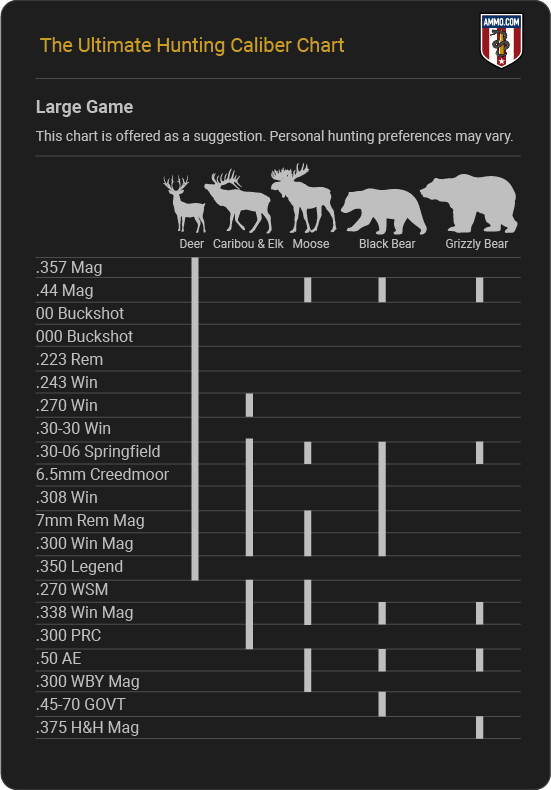
Deer Hunting Calibers
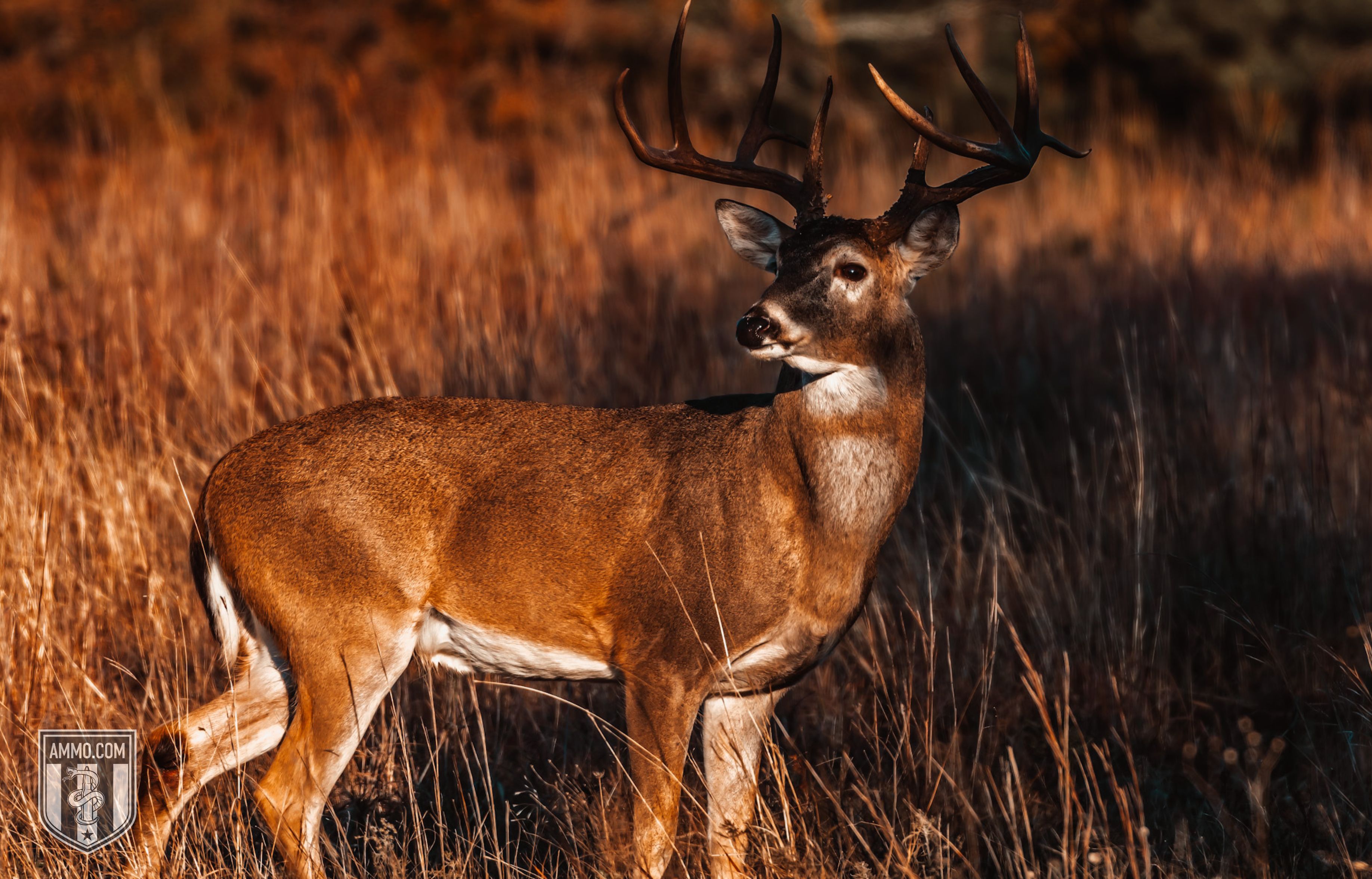
Deer (mule deer, whitetail and blacktail) hunters use various shot sizes, as well as handgun and rifle cartridges. Some states only allow straight-walled cartridges, while others are less restrictive and allow bottleneck cartridges. Here are some of the most commonly used shot types and calibers:
- .357 Mag
- .44 Mag
- 00 Buckshot
- 000 Buckshot
- .223 Rem
- .243 Win
- .270 Win
- .30-30 Win
- .30-06 Springfield
- 6.5mm Creedmoor
- .308 Win
- 7mm Rem Mag
- .300 Win Mag
- .350 Legend
| .357 Mag | The .357 Magnum is a close-range deer-hunting machine when chambered in a lever-action carbine. |
| .44 Mag | More powerful than the .357 Mag, the .44 Mag is another close-range deer nightmare when chambered in a carbine. |
| 00 Buck | Shotgunners often opt for 12 gauge or 10 gauge 00 buckshot. |
| 000 Buck | If the brush is a little thicker – or you simply need more power from your shotgun – try stepping up to 000 buckshot for shots within 50 yards. |
| .223 Rem | The .223 Rem is a little controversial as a deer hunting cartridge, but many states allow it despite being underpowered for shots over 100 yards. |
| .243 Win | The .243 Win is perfect for recoil-sensitive hunters and can ethically harvest deer out to 300 yards. |
| .270 Win | Initially designed for deer hunting, the .270 Win has withstood the test of time and can ethically harvest deer out to 400+ yards. |
| .30-30 Win | As a young hunter, I shot my first deer at 50 yards with a .30-30 Winchester. The .30-30 is an excellent brush gun, but it doesn’t have the trajectory of the .270 Win. |
| .30-06 Springfield | The “aught six” is one of the most prolific deer cartridges on the market and has been around for many decades. If there was a perfect deer round, the .30-06 comes as close as any other. |
| 6.5 Creedmoor | For long-range deer hunting, it’s tough to beat the 6.5 Creedmoor. Its flat trajectory, medium recoil, and stopping power capabilities have impressed more than a few deer hunters. |
| .308 Win | Another excellent deer cartridge is the .308 Win. It harvests deer at close and long range. |
| 7mm Rem Mag | The 7mm Rem Mag is a solid choice for hunters looking to extend their range. It’s not the biggest or fastest, but it gets the job done. |
| .300 Win Mag | Long-range deer hunters should look no further than the .300 Win Mag. It carries its energy for incredible distances and takes game animals much larger than deer. |
| .350 Legend | The .350 Legend is a straight-walled cartridge designed for deer hunting in states that prohibit bottlenecked cartridges. It has a mild recoil but lacks long-range capabilities. |
Caribou & Elk Hunting Calibers
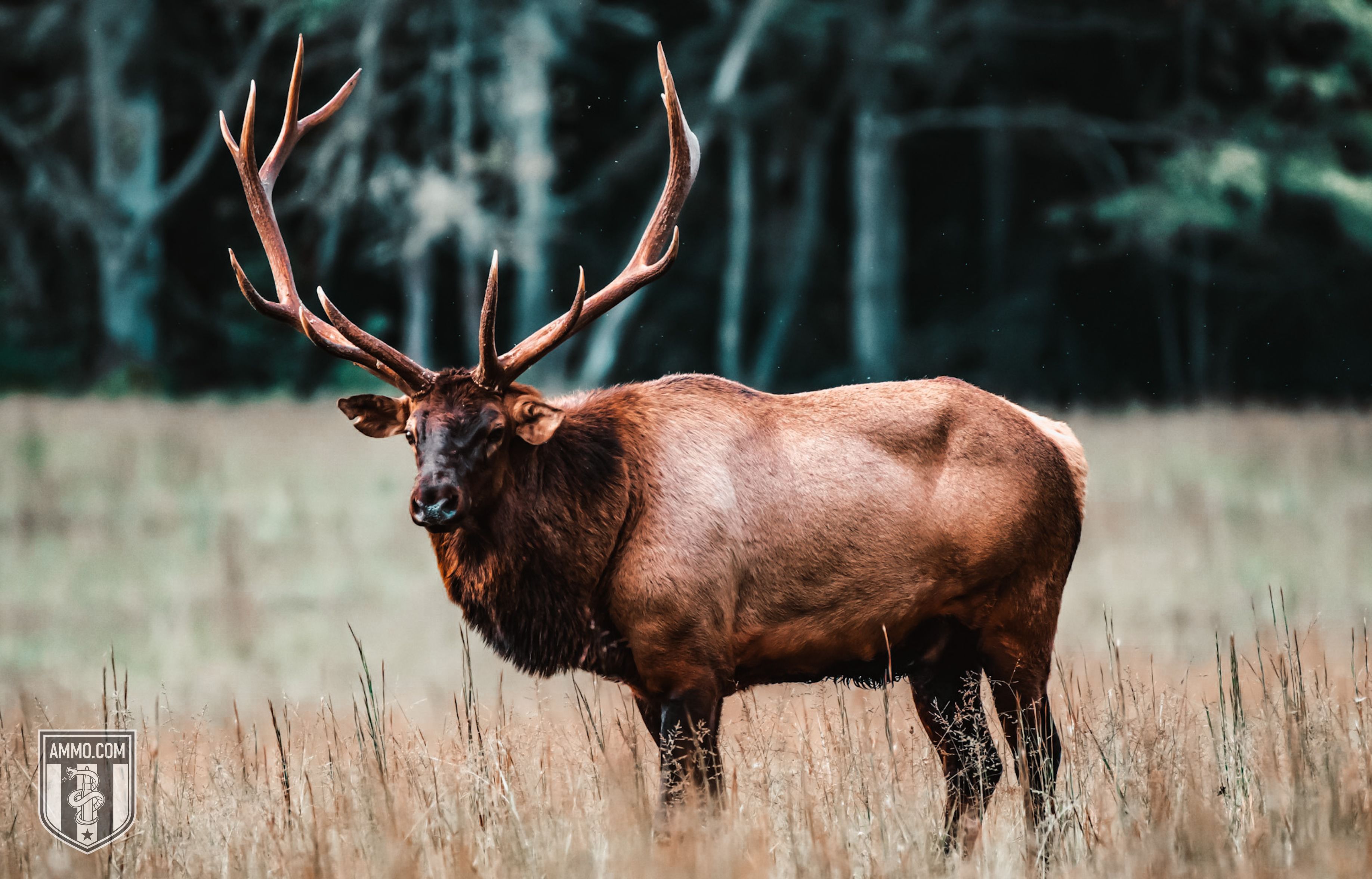
Elk and caribou (i.e. reindeer) are similar in size, and hunters often use the same firearms to harvest both species. Long shots are required for both species due to the environment they live in, so flat-shooting cartridges are preferred. These include:
- .270 Win
- .270 WSM
- .308 Win
- .30-06 Springfield
- 6.5mm Creedmoor
- 7mm Rem Mag
- .300 Win Mag
- .338 Win Mag
- .300 PRC
| .270 Win | I’ve killed an elk with a .270 Win, but it would have been a much faster hunt had I used a round with a flatter trajectory and farther effective range. The .270 Win will get the job done within 200 yards. |
| .270 WSM | The .270 WSM has a flatter trajectory, slightly extending your range on elk and caribou without drastically increasing recoil. |
| .308 Win | The long-distance capabilities of the .308 Winchester make it an ideal cartridge for reindeer and elk. |
| .30-06 Springfield | Though it doesn’t have the flattest trajectory, the .30-06 gives hunters plenty of range to harvest elk or caribou. It’s a tried and true hunting cartridge. |
| 6.5 Creedmoor | The 6.5 Creedmoor’s flat trajectory and ability to carry energy downrange make it an excellent choice for elk and caribou, despite some believing it’s too small to be effective. |
| 7mm Rem Mag | The 7mm Remington Magnum is more than capable of ethically harvesting caribou and elk at 300+ yards. |
| .300 Win Mag | This magnum cartridge allows hunters to harvest reindeer and elk from incredible distances, but it’s got some kick. |
| .338 Win Mag | Thanks to its ability to conserve energy downrange, the .338 Winchester Magnum can ethically harvest elk and caribou from 500+ yards away. |
| 300 PRC | The .300 PRC is accurate, retains energy, and has a flat trajectory. It gives elk nightmares. |
Moose Hunting Calibers

As the largest member of the deer family, moose are tough creatures to hunt. Because they’re large and primarily stick to habitats, they can quickly disappear in a thicket. So you’re unlikely to hunt them from far away. Most moose hunts end within 100 yards but can stretch well over 400 yards in mountain meadows. These are the calibers most moose hunters prefer:
- .44 Mag
- .50 Action Express (AE)
- .270 WSM
- .30-06 Springfield
- 7mm Rem Mag
- .300 Win Mag
- .338 Win Mag
- .300 WBY Mag
| .44 Mag | The .44 Magnum is great as a backup handgun because you’ll likely be hunting in thick brush where it is difficult to shoulder a rifle quickly. |
| .50 AE | The 50 AE has tremendous stopping power for a handgun cartridge. It also comes with tremendous recoil, so be prepared to hang on to this hand-cannon. |
| .270 WSM | The .270 WSM is less than ideal for moose at longer distances. At close range, it packs plenty of punch to harvest a bull moose ethically. |
| .30-06 Springfield | It’s often said that the .30-06 has taken more moose than any other cartridge, and I believe it. It’s an effective round for many species, especially in a thicket. |
| 7mm Rem Mag | The 7mm Rem Mag allows you to reach moose farther away than the options listed above, as it does an excellent job of maintaining its energy downrange. |
| .300 Win Mag | Thanks to its accuracy and ability to conserve energy, the .300 Win Mag ensures that you can harvest moose from 500 yards away. |
| .338 Win Mag | The .338 Win Mag is another excellent long-distance moose cartridge. If you know you’ll have farther shot opportunities, this will be your choice (but your shoulder won’t be thanking you after firing it). |
| .300 WBY Mag | The .300 WBY Mag promises over 1,600 ft-lbs of energy at 500 yards, which is more than enough to harvest a moose at that distance. |
Black Bear Hunting Calibers
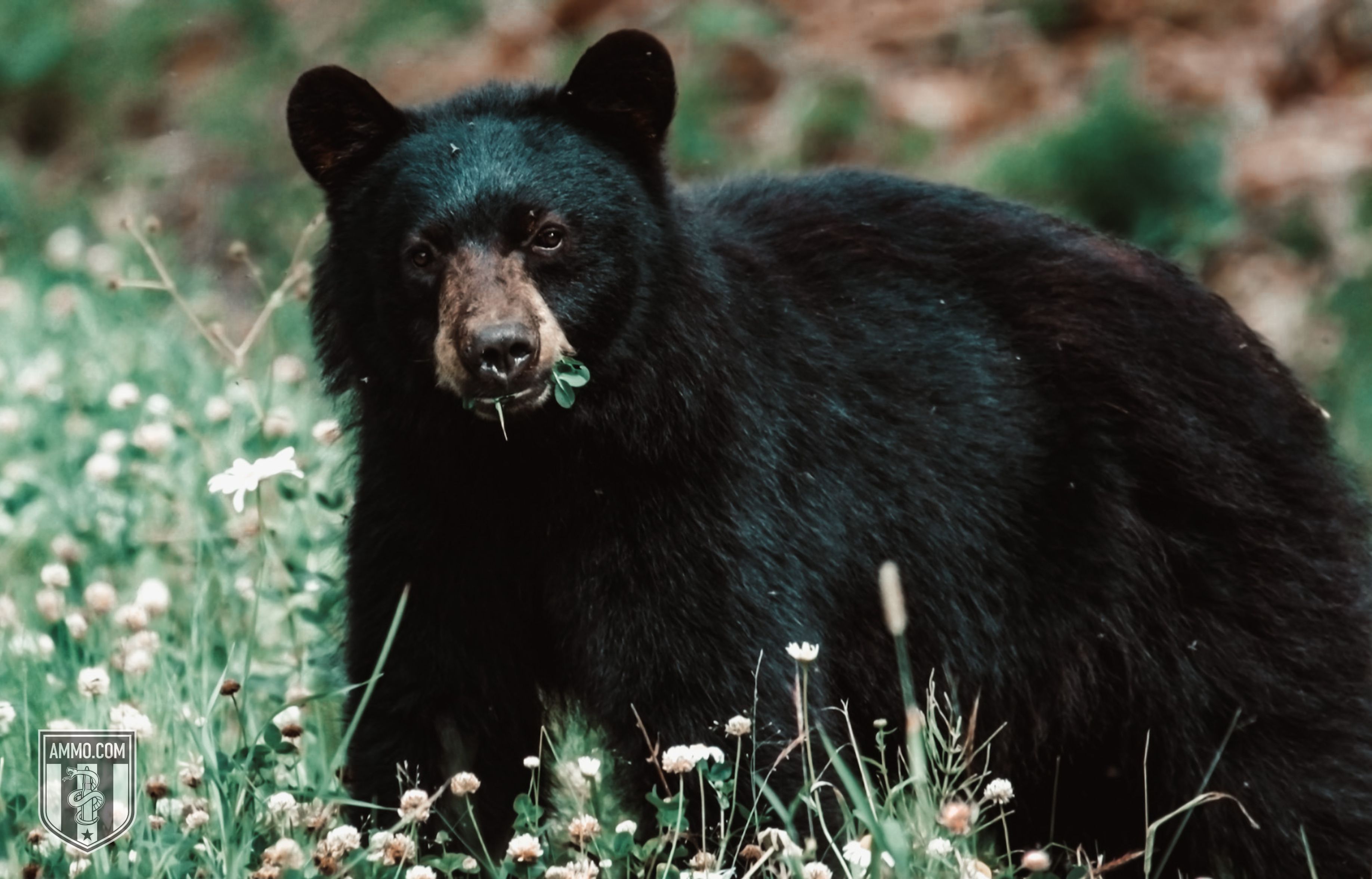
Black bears are smaller than their brown bear cousins, but they are still plenty tough and require bigger calibers and sometimes multiple shots. These are the most common black bear cartridges:
| .44 Mag | The .44 Mag is an excellent defense round against black bears and can be used to hunt bears in a carbine. |
| 50 AE | The 50 AE is another excellent handgun cartridge capable of defending against a black bear attack. Be sure to hold onto your hand cannon, as the 50 AE generates stout recoil energy. |
| .308 Win | Capable of taking any big game in North America, the .308 Win is a solid choice for black bear hunting even as you increase the distance. |
| 6.5 Creedmoor | The 6.5 Creedmoor rifle cartridge can extend the range on black bears, although most bear encounters occur within 100 yards. |
| .30-06 Springfield | As one of the most capable big game hunting cartridges ever, the .30-06 Springfield offers hunters plenty of power to stop any black bear. |
| 7mm Rem Mag | The 7mm Rem Mag gives black bear hunters a range of over 500 yards, but is capable at the closer distances where you’ll likely encounter a bear. |
| .300 Win Mag | The .300 Win Mag will quickly end any threat a black bear might present at close range, and has more than enough energy to stretch that distance. |
| .45-70 GOVT | The .45-70 is an old-school straight-walled cartridge that launches a giant 250-405 grain bullet downrange. With a single shot, it can stop a charging bear. |
Grizzly Bear Hunting Calibers
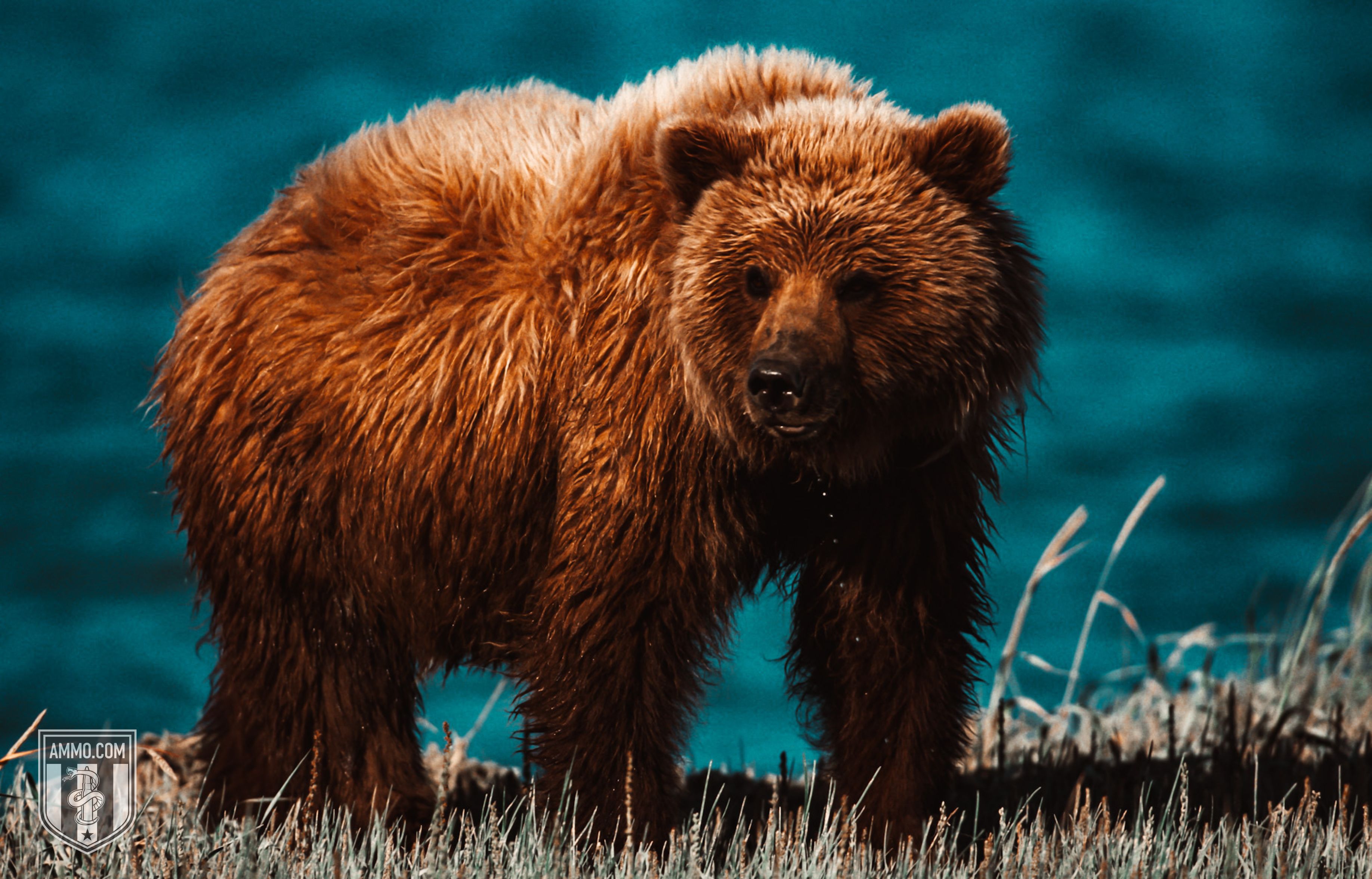
Brown bears – or grizzlies, as they’re also known – are giant fur balls capable of wreaking absolute havoc. They’re incredibly tough and often need powerful cartridges to stop them in their tracks at close distances. That includes calibers such as:
| .44 Mag | The .44 Magnum is often used for bear defense, especially when paired with hardcast bullets. |
| .50 AE | The .50 AE can stop the largest brown bear at a close distance. |
| .30-06 Springfield | The .30-06 Springfield should be the smallest caliber you use to hunt grizzly bears, even though smaller calibers have successfully harvested brown bears. |
| .338 Win Mag | The .338 Win Mag will slow a grizzly with a poorly placed shot and drop one with a well-placed shot. |
| .375 H&H Mag | The .375 H&H Mag packs a tremendous amount of energy at 100 yards, which is farther than most grizzly encounters. If you want a round that’ll stop a bear in its tracks, the .375 H&H Magnum will do it. |
Parting Shots: Hunting Caliber Chart
While these hunting caliber charts cover the spectrum of hunting cartridges, they are by no means all-encompassing. There is no one way to hunt; as you can tell from above, many cartridges overlap, but we, as hunters, have our preferences.
Infographics
- Are Guns & Ammo The New Gold? Why More Americans Are Arming Themselves
- The Greatest Gun Salesman In America: President Barack Obama
- Shooting Straight: How Both Presidential Candidates Have Changed On Gun Control
- President Obama: (Still) The Greatest Gun Salesman in America
- An Inconvenient Truth: How The Obama Administration Became Earth's Largest Arms Dealer
- Armed Drones: President Obama's Weapon of Choice
- COVID-19 Data Study: Ammunition Sales Continue to Soar in Response to Coronavirus Panic
- Data Study: 18 Months of Ammo Sales during a Pandemic, Protests, and the Biden Presidency
- Data Study: U.S. Ammo Sales Surge Following Russian Invasion of Ukraine
- Most Gun-Friendly States in 2024
- Worst States to be a Gun Owner (2024 Updated)
- Children & Firearms: Definitions and Demographics Make All the Difference
- Urban Violent Crime & Legal Gun Ownership
- Gun-Free School Zone Laws & School Shootings (2024 Updated)
- Gun Control Laws and Enforcement Trends 2024
- Gun Ownership by State (2024 Statistics)
- How Many Gun Owners are in America? (2024 Statistics)
- Concealed Carry Crime Stats 2024
- Accidental Shooting Statistics: A Review of Unintentional Firearm Deaths from 1979-2024
- America’s Stolen Guns: A Silent Contributor to Gun Crimes in the U.S. (2024)
- Gun Violence Statistics 2024: Comprehensive Look at the Data
- Gun Laws vs. Crime Rates in 2024: A Comprehensive Analysis
- Gun Death Statistics by Caliber: A Review of Calibers and Crime in 2024
- Anti-Gun Control Arguments 2024: Facts Gun Control Lobby Suppress
- Guns in the Home Statistics: The Effects of Firearms in the Home in 2024
- Gun Deaths in the US: Analyzing At-Risk Demographics in 2024
- How Many Guns in the U.S.: All About America’s Firearms in 2024
- Gun Facts in the U.S. 2024: The Reality of Firearms in America
- Defensive Gun Use Statistics: America’s Life-Saving Gun Incidents (2024)
- Correlation Between Mass Shootings and Prescription Drugs (2024 Study)
- Gun Ownership by Gender in 2024: Closing the Gender Gap
- Murders by Weapon Type: September 2024 Statistics
- Gun Violence Among Black Americans: September 2024 Statistics
- The Ultimate Hunting Caliber Chart: Best Cartridge Per Species
- How Old Do You Have to be to Buy a Gun: A State Guide 2024
- Most Popular Guns in the U.S.: The Must-Have Guns in 2024
- Stray Bullet Deaths: Accident and Injury Statistics in September 2024
- Mass Shooters by Race: Demographics of Assailants 1966-2024
- Ammunition Limits By State in 2024: How Much Ammo Can You Buy?
- Why Do Americans Own Guns in 2024?
- How Many Americans Want Stricter Gun Laws in 2024?
- How Many Households in the U.S. Have a Gun in 2024?
- What Percentage of Gun Deaths are Suicides in 2024?
- Average Age of Mass Shooters in the U.S.
- Firearm Ownership in America by Year
- US Firearms Deaths Per Year: A Collective Report 1968-2024
- Percentage of Americans Owning Guns in 2024
- Texas Gun Ownership: Total Numbers, Trends, and Most Popular Guns
- Gun Ownership Statistics Colorado 2025: Trends & Numbers
- Hunting Accident Statistics 2025 (Causes & Trends Per Year)
- Banned Guns & Ammo List: A 2025 Review by State
- 3D Printed Gun Laws By State
- How To Build a Home Shooting Range: The Ultimate Guide
- States With the Highest Murder Rates
- Best Self-Defense Weapons for Women
